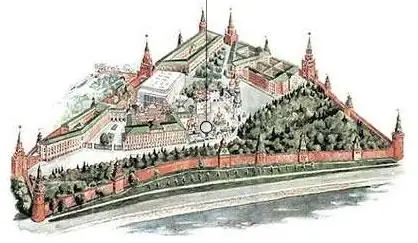- Author Harold Hamphrey [email protected].
- Public 2023-12-17 10:06.
- Last modified 2025-01-24 11:10.
The undisputed architectural dominant of the Palace Square in St. Petersburg is the famous Alexandria Column. Since childhood, her image has entered the consciousness of several generations of Russian people, even those who have never been on the banks of the Neva. But Pushkin's textbook poems, where she is mentioned, are known to everyone. At the same time, not everyone will remember that the Alexandrian Column was erected in honor of commemorating the victory of Russian weapons over Napoleon in the Patriotic War of 1812. Often it is perceived as nothing more than the axis of symmetry of the architectural ensemble and the center of the overall composition, uniting the brilliant creations of Rossi and Rastrelli into a single whole. Of course, this is a mere convention, but it is considered to be the symbolic center not only of Palace Square, but of the whole of St. Petersburg.

History of Creation
The Alexandrian column on the Palace Square was erected according to the design of the great architect Auguste Montferrand. There is a certain element of chance in its erection. Montferrand devoted forty years of his life to the construction of St. Isaac's Cathedral. Granite for the construction of its colonnades was mined in the Karelian rocks. One of the monolithicblanks weighed a thousand tons, and its pink granite was of amazing quality. The length also greatly exceeded the required. Cutting such a gift of nature was just a pity. And it was decided to use the whole monolith. The Alexandria column was made right at the place of production of a monolithic billet. The work was carried out by Russian stone-cutters. For its delivery to the capital along the Neva, a special barge had to be designed and built. The action took place in 1832. After delivery to the destination and all the preparatory work, the final installation took only an hour and a half. The Alexandrian column was brought to a vertical position through a system of levers with the help of the physical efforts of two and a half thousand workers and soldiers of the capital's garrison. The construction was completed in 1834. A little later, the pedestal was decorated with ornaments and surrounded by a low fence.

Some technical details
The column on Palace Square is to this day the tallest triumphal building of its kind in all of Europe. Its height is 47 and a half meters. It is carefully polished and has an equal diameter along its entire length. The uniqueness of this monument is also in the fact that it is not fixed by anything and stands on a solid foundation solely under the influence of its own weight. The bicentennial anniversary of this building is not so far away. But during this time, not even the slightest deviation from the vertical of the six-hundred-ton monolith was observed. There are no signs of subsidence of the foundationunder him. Such was the precision of Auguste Richard Montferrand's engineering calculation.

During the war, bombs and long-range artillery shells exploded near the column. The Alexandrian column survived those who shot at it and, apparently, intends to stand unshakably for a very long time. The metal angel on its top is also not fixed by anything, but is not going to fly anywhere.






